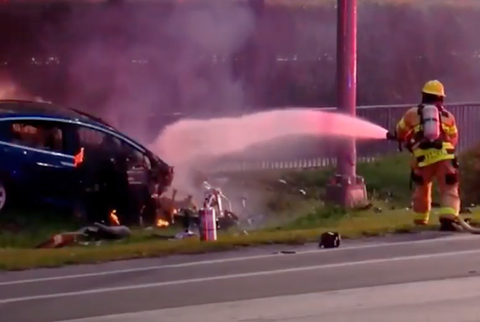
National Fire Protection Association via YouTube
- The National Transportation Safety Board says the U.S. is woefully unprepared to deal with EV fires, which require different strategies than gasoline vehicle fires.
- 31 percent of fire departments don’t train for EV fires, and half say they don’t have special protocols in place to deal with EVs after a crash, the agency’s report found.
- Note the caveats, though. There are more than 29,000 fire departments in the U.S. This survey only asked for information from 32 of them.
If you have been reading Car and Driver for a while, there’s a decent chance you remember the news when a Tesla Model S caught fire in 2013. Or that the NTSB was investigating Tesla fires in 2019. Or when a Porsche Taycan went up in flames earlier this year.
You might remember those things, because electric-vehicle fires make headlines. Of course, the reality is that, according to the U.S. Fire Administration (USFA), an average of 171,500 highway vehicle fires happened in the United States each year from 2014 through 2016, and the vast majority of them were in gasoline-powered cars. Nonetheless, electric vehicles are still a shiny new thing to many people, and when something goes wrong with them, we notice. Automakers build safety systems into their battery packs, including rapid discharging in the event of a crash, but fires still happen, just as they can with gasoline-powered vehicles.
Which is why a new report from the National Transportation Safety Board (NTSB) has some alarming data. Most important is that half of U.S. fire departments are not prepared to deal with an electric-vehicle fire. In fact, 31 percent said they don’t have any kind of specific training for their firefighters to deal with hybrid or electric vehicles, and fully half said they have no post-crash protocols in place to deal with hybrid or electric vehicles.
This is important because putting out different kinds of fires requires different strategies, and a burning gas tank is not the same as burning lithium-ion battery cell pouches. The USFA says EV fires “can exceed 5000 degrees Fahrenheit” and “applying water or foam may cause a violent flareup as the water molecules separate into explosive hydrogen and oxygen gases.” There are also risks of electric shock and toxic fumes in an electric vehicle fire that aren’t present in gasoline fires, or at least not in the same way. So training first responders to safely put out an EV fire is important as the number of EVs increases in the U.S. The NTSB says this just isn’t happening yet.
Despite the alarming tone in the in the NTSB report, there are a fair number of caveats to consider. The first is that the NTSB based this report on a survey of just 32 fire departments. The USFA says there were an estimated 29,705 fire departments in the U.S. in 2018, so this is nowhere near a representative sample.
Second, the NTSB doesn’t say where the unprepared fire departments are, but it’s logical to think that preparing for an EV fire is less important for a fire fighter in rural North Dakota than it is for one in California. As EVs become more common across the country, we can only hope more fire departments get the training they need.
There also seems to be some discrepancy in the survey results. For example, when asked “What type of training is currently being administered to your responders for hybrid electric/electric vehicles?” 10 respondents said they have no such training. But then, for the next question, which asked which tools the departments use for this kind of training, all 32 named at least one type of training tool they were using. Both of those things cannot be true.
This content is imported from YouTube. You may be able to find the same content in another format, or you may be able to find more information, at their web site.
Despite those caveats, we can still learn something from this NTSB report, which is that first responders need to be taught how to safely deal with electric-vehicle fires. There are new tools to help keep firefighters safe, including a “hot stick” that can detect the presence of an AC or a DC current. As the video above shows, the National Fire Protection Association is reporting the use of new techniques firefighters are developing for EV fire situations, such as elevating the burning vehicle so water can reach the entire battery pack or building a dam around the vehicle to soak it in water. And, most important, training protocols are available and need to be used.
This content is imported from {embed-name}. You may be able to find the same content in another format, or you may be able to find more information, at their web site.
This content is created and maintained by a third party, and imported onto this page to help users provide their email addresses. You may be able to find more information about this and similar content at piano.io
